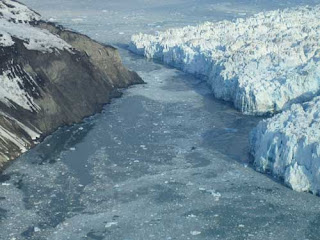AIM: To be able to understand how glaciers move and the different zones of a glacier.
Ice movement is generally very complex, for a mass of ice to be titled a glacier it must be capable of motion. The sheer weight of the layer of ice combined with gravity causes glaciers to flow through plastic deformation very slowly down mountain valleys, across upland plains or stream into the ocean. In most mountain glaciers, flow of ice begins with accumulations of ice and snow exceeding 20 metres.
Figure 1: Diagram illustrating the cross section of a glacier, showing all important features. (Reference)
The diagram above shows the cross section of a glacier, which helps us to understand the differing flow rates throughout the mass of ice. By referring back to glacial budgets we can identify different zones and the line of equilibrium that control the retreat or advance of the glacier.
The upper part of the glacier is where input material exceeds the output. Therefore more mass is gained than lost over a period of a year. This is named the zone of ACCUMULATION.
The lower part of the glacier is where the output material exceeds the inputs. Therefore mass is lost rather than gained over the period of a year. This is named the zone of ABLATION.
Between the two zones is the line of EQUILIBRIUM. This separates net loss from net gain and represents the line of snow upon the glacier.
The difference between the total accumulation and the total ablation during the period of a year is known as the NET BALANCE.
In temperate glaciers, there will be a negative net balance in summer due to ablation exceeding accumulation and then therefore the reverse in winter. If these seasonal budgets cancel each other out then the glacier will remain stationary.
If the supply begins to exceed the losses the front, or snout, of the glacier will move down the valley. This is known as GLACIAL ADVANCE.
When the reverse happens and the glacier begins to lose volume the snout will move its position up the valley. This is known as GLACIAL RETREAT.
Velocity of flow rates:
Flow rates within a glacier are not uniform, figure 2 illustrates that from directly above it seems that the middle of the glacier appears to be flowing at its greatest speed. On the sides of the glacier, flow rate is decreased due to the frictional effects of the valley sides, therefore slowing the glacier sides down. This frictional effect can also be applied to the bottom of the glacier, which is slowed down by the bedrock (see figure 3).
Figure 2: Diagram illustrating an overhead view of a glaicer showing the relative speed of ice movement. (Reference)
Figure 3: A cross section of an alpine valley glacier showing the relative rates of movement. (Reference)
A variety of factors influence the velocity of flow rates within a glacier, the more important ones including the gradient of the valley floor, the temperate and the thickness of the ice itself, and the constriction with the valley walls.
Another factor is known as BASAL SLIDING. This occurs when the weight of the glacier causes immense pressure at the area of contact with the bedrock, causing the ice to melt (pressure melting). This melting ice then forms a layer of water that reduces the friction between the glacial ice and the ground surface. This water then lubricates and facilities the movement of the glacier due to the lack of friction it gives.
Average rates of movement are less than 1 metre per year.
Surging glaciers:
At certain points in time glaciers may break their natural rhythm and surge forward, racing several metres per day for weeks or months. An example of this is in 1986 the Hubbard Glacier in Alaska began to surge at the rate of 10 metres per day across the mouth of the Russell Fiord. In two months, the glacier had dammed water within the fjord and created a lake therefore changing the landscape.
Figure 4: Image showing the Hubbard Glacier (Reference)
IN PRACTICE: This lesson illustrates that a glacier is not just one mass of ice and that it has different zones and levels of velocity that aids the movement. There are a lot of definitions and terms to use in this lesson so it would be useful to add it to the topic glossary and have the students learn the definitions for homework to prepare for a quick starter task of fitting the right definition with the right description.
References:
NSIDC (2010) "Why do glaciers move?" Available at http://nsidc.org/glaciers/questions/move.html [Accessed 02/09/2011]
Physical Geography (1999-2010) "Glacial Processes" Available at http://www.physicalgeography.net/fundamentals/10ae.html [Accessed 02/09/2011]
Redfern, D & Skinner, M (2005) Advanced Geography. 2nd Edition. Philip Allan Updates, Oxfordshire




No comments:
Post a Comment